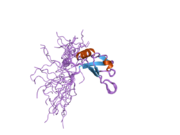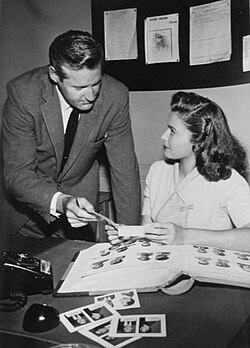뉴클레올린
Nucleolin| NCL | |||||||||||||||||||||||||
|---|---|---|---|---|---|---|---|---|---|---|---|---|---|---|---|---|---|---|---|---|---|---|---|---|---|
 | |||||||||||||||||||||||||
| |||||||||||||||||||||||||
| 식별자 | |||||||||||||||||||||||||
| 별칭 | NCL, C23, 핵솔린, Nsr1 | ||||||||||||||||||||||||
| 외부 ID | OMIM: 164035 MGI: 97286 HomoloGene: 136488 GeneCard: NCL | ||||||||||||||||||||||||
| |||||||||||||||||||||||||
| |||||||||||||||||||||||||
| |||||||||||||||||||||||||
| |||||||||||||||||||||||||
| 직교체 | |||||||||||||||||||||||||
| 종 | 인간 | 마우스 | |||||||||||||||||||||||
| 엔트레스 | |||||||||||||||||||||||||
| 앙상블 | |||||||||||||||||||||||||
| 유니프로트 | |||||||||||||||||||||||||
| RefSeq(mRNA) | |||||||||||||||||||||||||
| RefSeq(단백질) | |||||||||||||||||||||||||
| 위치(UCSC) | Chr 2: 231.45 – 231.48Mb | Chr 1: 86.27 – 86.29Mb | |||||||||||||||||||||||
| PubMed 검색 | [3] | [4] | |||||||||||||||||||||||
| 위키다타 | |||||||||||||||||||||||||
| |||||||||||||||||||||||||
뉴클레올린은 인간에게 NCL 유전자에 의해 암호화된 단백질이다.[5][6]
유전자
인간 NCL 유전자는 2번 염색체에 위치하며 13개의 인트론을 가진 14개의 엑손으로 구성되며 약 11kb에 이른다.NCL 유전자의 인트론 11은 U20이라고 불리는 작은 핵극 RNA를 암호화하고 있다.[7]
함수
뉴클레올린은 진핵세포가 자라는 주요 핵단백질이다.그것은 핵내 염색질 및 리보솜 이전의 입자와 연관되어 발견된다.히스톤 H1에 결합하여 염색질 감응을 유도한다.RNA 전사와 리보솜 조립에 역할을 하는 것으로 생각된다.전사의 연장 과정에서 역할을 할 수 있다.RNA 올리고뉴클레오티드를 5'-UUAGG-3'로 결합하면 단층 단일 가닥 DNA 5'-TTAGGG-3'가 반복하는 것보다 더 촘촘하게 반복된다.
뉴클레올린은 또한 치킨 오벌부민 업스트림 프로모터 전사 인자 II(COUP-TFII)와 함께 전사 공동 활성제 역할을 할 수 있다.[8]
임상적 유의성
미딘과 플리오트로핀은 낮은 친화력 수용체로서 세포 표면 뉴클레오린과 결합한다.이 결합은 HIV 감염을 억제할 수 있다.[9][10]
세포 표면의 뉴클레오린(Nucleolin)은 RSV(Respiratory Syncytial Virus) 융합 단백질의 수용체다.[11]뉴클레오린 - RSV 융합 단백질 상호작용에 대한 간섭은 세포 배양 및 동물 모델에서 RSV 감염에 대한 치료 효과가 있는 것으로 나타났다.[12][13][14][15]
상호작용
뉴클레올린은 다음과 상호작용하는 것으로 나타났다.
참조
- ^ a b c GRCh38: 앙상블 릴리스 89: ENSG00000115053 - 앙상블, 2017년 5월
- ^ a b c GRCm38: 앙상블 릴리스 89: ENSMUSG000026234 - 앙상블, 2017년 5월
- ^ "Human PubMed Reference:". National Center for Biotechnology Information, U.S. National Library of Medicine.
- ^ "Mouse PubMed Reference:". National Center for Biotechnology Information, U.S. National Library of Medicine.
- ^ Srivastava M, McBride OW, Fleming PJ, Pollard HB, Burns AL (Sep 1990). "Genomic organization and chromosomal localization of the human nucleolin gene". The Journal of Biological Chemistry. 265 (25): 14922–31. doi:10.1016/S0021-9258(18)77205-0. PMID 2394707.
- ^ Erard MS, Belenguer P, Caizergues-Ferrer M, Pantaloni A, Amalric F (Aug 1988). "A major nucleolar protein, nucleolin, induces chromatin decondensation by binding to histone H1". European Journal of Biochemistry. 175 (3): 525–30. doi:10.1111/j.1432-1033.1988.tb14224.x. PMID 3409881.
- ^ "Entrez Gene: NCL nucleolin".
- ^ Litchfield LM, Riggs KA, Hockenberry AM, Oliver LD, Barnhart KG, Cai J, Pierce WM, Ivanova MM, Bates PJ, Appana SN, Datta S, Kulesza P, McBryan J, Young LS, Klinge CM (May 2012). "Identification and characterization of nucleolin as a COUP-TFII coactivator of retinoic acid receptor β transcription in breast cancer cells". PLOS ONE. 7 (5): e38278. Bibcode:2012PLoSO...738278L. doi:10.1371/journal.pone.0038278. PMC 3365040. PMID 22693611.
- ^ Said EA, Krust B, Nisole S, Svab J, Briand JP, Hovanessian AG (Oct 2002). "The anti-HIV cytokine midkine binds the cell surface-expressed nucleolin as a low affinity receptor". The Journal of Biological Chemistry. 277 (40): 37492–502. doi:10.1074/jbc.M201194200. PMID 12147681. S2CID 41621217.
- ^ Said EA, Courty J, Svab J, Delbé J, Krust B, Hovanessian AG (Sep 2005). "Pleiotrophin inhibits HIV infection by binding the cell surface-expressed nucleolin". The FEBS Journal. 272 (18): 4646–59. doi:10.1111/j.1742-4658.2005.04870.x. PMID 16156786. S2CID 21153881.
- ^ Tayyari F, Marchant D, Moraes TJ, Duan W, Mastrangelo P, Hegele RG (Sep 2011). "Identification of nucleolin as a cellular receptor for human respiratory syncytial virus". Nature Medicine. 17 (9): 1132–5. doi:10.1038/nm.2444. PMID 21841784. S2CID 205388029.
- ^ Bilawchuk LM, Griffiths CD, Jensen LD, Elawar F, Marchant DJ (Aug 2017). "The Susceptibilities of Respiratory Syncytial Virus to Nucleolin Receptor Blocking and Antibody Neutralization are Dependent upon the Method of Virus Purification". Viruses. 9 (8): 207. doi:10.3390/v9080207. PMC 5580464. PMID 28771197.
- ^ Mastrangelo P, Hegele RG (Nov 2012). "The RSV fusion receptor: not what everyone expected it to be". Microbes and Infection / Institut Pasteur. 14 (13): 1205–10. doi:10.1016/j.micinf.2012.07.015. PMID 22884716.
- ^ Mastrangelo P, Hegele RG (Mar 2013). "RSV fusion: time for a new model". Viruses. 5 (3): 873–85. doi:10.3390/v5030873. PMC 3705301. PMID 23518574.
- ^ Shakeri A, Mastrangelo P, Griffin JK, Moraes TJ, Hegele RG (Nov 2014). "Respiratory syncytial virus receptor expression in the mouse and viral tropism". Histology and Histopathology. 30 (30): 401–411. doi:10.14670/HH-30.401. PMID 25374027.
- ^ Lee, Seong-Jae, et al. (Jun 2021). "Identification of Nucleolin as a Novel AEG-1-Interacting Protein in Breast Cancer via Interactome Profiling". Cancers. 13 (11): 2842. doi:10.3390/cancers13112842. PMID 34200450. S2CID 235436955.
- ^ Li D, Dobrowolska G, Krebs EG (Jun 1996). "The physical association of casein kinase 2 with nucleolin". The Journal of Biological Chemistry. 271 (26): 15662–8. doi:10.1074/jbc.271.26.15662. PMID 8663258. S2CID 10750338.
- ^ Dubois T, Zemlickova E, Howell S, Aitken A (Feb 2003). "Centaurin-alpha 1 associates in vitro and in vivo with nucleolin". Biochemical and Biophysical Research Communications. 301 (2): 502–8. doi:10.1016/s0006-291x(02)03010-3. PMID 12565890.
- ^ Tominaga K, Srikantan S, Lee EK, Subaran SS, Martindale JL, Abdelmohsen K, Gorospe M (Oct 2011). "Competitive regulation of nucleolin expression by HuR and miR-494". Molecular and Cellular Biology. 31 (20): 4219–31. doi:10.1128/MCB.05955-11. PMC 3187287. PMID 21859890.
- ^ Li YP, Busch RK, Valdez BC, Busch H (Apr 1996). "C23 interacts with B23, a putative nucleolar-localization-signal-binding protein". European Journal of Biochemistry. 237 (1): 153–8. doi:10.1111/j.1432-1033.1996.0153n.x. PMID 8620867.
- ^ Daniely Y, Dimitrova DD, Borowiec JA (Aug 2002). "Stress-dependent nucleolin mobilization mediated by p53-nucleolin complex formation". Molecular and Cellular Biology. 22 (16): 6014–22. doi:10.1128/mcb.22.16.6014-6022.2002. PMC 133981. PMID 12138209.
- ^ Morimoto H, Okamura H, Haneji T (Sep 2002). "Interaction of protein phosphatase 1 delta with nucleolin in human osteoblastic cells". The Journal of Histochemistry and Cytochemistry. 50 (9): 1187–93. doi:10.1177/002215540205000905. PMID 12185196. S2CID 24950287.
- ^ Sakaguchi M, Miyazaki M, Takaishi M, Sakaguchi Y, Makino E, Kataoka N, Yamada H, Namba M, Huh NH (Nov 2003). "S100C/A11 is a key mediator of Ca(2+)-induced growth inhibition of human epidermal keratinocytes". The Journal of Cell Biology. 163 (4): 825–35. doi:10.1083/jcb.200304017. PMC 2173690. PMID 14623863.
- ^ Fouraux MA, Bouvet P, Verkaart S, van Venrooij WJ, Pruijn GJ (Jul 2002). "Nucleolin associates with a subset of the human Ro ribonucleoprotein complexes". Journal of Molecular Biology. 320 (3): 475–88. doi:10.1016/s0022-2836(02)00518-1. PMID 12096904.
- ^ Haluska P, Saleem A, Edwards TK, Rubin EH (Apr 1998). "Interaction between the N-terminus of human topoisomerase I and SV40 large T antigen". Nucleic Acids Research. 26 (7): 1841–7. doi:10.1093/nar/26.7.1841. PMC 147454. PMID 9512561.
- ^ Bharti AK, Olson MO, Kufe DW, Rubin EH (Jan 1996). "Identification of a nucleolin binding site in human topoisomerase I". The Journal of Biological Chemistry. 271 (4): 1993–7. doi:10.1074/jbc.271.4.1993. PMID 8567649. S2CID 25059254.
- ^ Khurts S, Masutomi K, Delgermaa L, Arai K, Oishi N, Mizuno H, Hayashi N, Hahn WC, Murakami S (Dec 2004). "Nucleolin interacts with telomerase". The Journal of Biological Chemistry. 279 (49): 51508–15. doi:10.1074/jbc.M407643200. PMID 15371412. S2CID 41394148.
추가 읽기
- Tuteja R, Tuteja N (1999). "Nucleolin: a multifunctional major nucleolar phosphoprotein". Critical Reviews in Biochemistry and Molecular Biology. 33 (6): 407–36. doi:10.1080/10409239891204260. PMID 9918513.
- Pasternack MS, Bleier KJ, McInerney TN (Aug 1991). "Granzyme A binding to target cell proteins. Granzyme A binds to and cleaves nucleolin in vitro". The Journal of Biological Chemistry. 266 (22): 14703–8. doi:10.1016/S0021-9258(18)98743-0. PMID 1860869.
- Belenguer P, Caizergues-Ferrer M, Labbé JC, Dorée M, Amalric F (Jul 1990). "Mitosis-specific phosphorylation of nucleolin by p34cdc2 protein kinase". Molecular and Cellular Biology. 10 (7): 3607–18. doi:10.1128/MCB.10.7.3607. PMC 360797. PMID 2192260.
- Srivastava M, Fleming PJ, Pollard HB, Burns AL (Jun 1989). "Cloning and sequencing of the human nucleolin cDNA". FEBS Letters. 250 (1): 99–105. doi:10.1016/0014-5793(89)80692-1. PMID 2737305. S2CID 8690886.
- Tuteja N, Huang NW, Skopac D, Tuteja R, Hrvatic S, Zhang J, Pongor S, Joseph G, Faucher C, Amalric F (Jul 1995). "Human DNA helicase IV is nucleolin, an RNA helicase modulated by phosphorylation". Gene. 160 (2): 143–8. doi:10.1016/0378-1119(95)00207-M. PMID 7642087.
- Jordan P, Heid H, Kinzel V, Kübler D (Dec 1994). "Major cell surface-located protein substrates of an ecto-protein kinase are homologs of known nuclear proteins". Biochemistry. 33 (49): 14696–706. doi:10.1021/bi00253a007. PMID 7993898.
- Nicoloso M, Caizergues-Ferrer M, Michot B, Azum MC, Bachellerie JP (Sep 1994). "U20, a novel small nucleolar RNA, is encoded in an intron of the nucleolin gene in mammals". Molecular and Cellular Biology. 14 (9): 5766–76. doi:10.1128/mcb.14.9.5766. PMC 359102. PMID 8065311.
- Ishikawa F, Matunis MJ, Dreyfuss G, Cech TR (Jul 1993). "Nuclear proteins that bind the pre-mRNA 3' splice site sequence r(UUAG/G) and the human telomeric DNA sequence d(TTAGGG)n". Molecular and Cellular Biology. 13 (7): 4301–10. doi:10.1128/MCB.13.7.4301. PMC 359985. PMID 8321232.
- Eggert M, Möws CC, Tripier D, Arnold R, Michel J, Nickel J, Schmidt S, Beato M, Renkawitz R (Dec 1995). "A fraction enriched in a novel glucocorticoid receptor-interacting protein stimulates receptor-dependent transcription in vitro". The Journal of Biological Chemistry. 270 (51): 30755–9. doi:10.1074/jbc.270.51.30755. PMID 8530516. S2CID 25642912.
- Bharti AK, Olson MO, Kufe DW, Rubin EH (Jan 1996). "Identification of a nucleolin binding site in human topoisomerase I". The Journal of Biological Chemistry. 271 (4): 1993–7. doi:10.1074/jbc.271.4.1993. PMID 8567649. S2CID 25059254.
- Li YP, Busch RK, Valdez BC, Busch H (Apr 1996). "C23 interacts with B23, a putative nucleolar-localization-signal-binding protein". European Journal of Biochemistry. 237 (1): 153–8. doi:10.1111/j.1432-1033.1996.0153n.x. PMID 8620867.
- Li D, Dobrowolska G, Krebs EG (Jun 1996). "The physical association of casein kinase 2 with nucleolin". The Journal of Biological Chemistry. 271 (26): 15662–8. doi:10.1074/jbc.271.26.15662. PMID 8663258. S2CID 10750338.
- Zhou G, Seibenhener ML, Wooten MW (Dec 1997). "Nucleolin is a protein kinase C-zeta substrate. Connection between cell surface signaling and nucleus in PC12 cells". The Journal of Biological Chemistry. 272 (49): 31130–7. doi:10.1074/jbc.272.49.31130. PMID 9388266.
- Haluska P, Saleem A, Edwards TK, Rubin EH (Apr 1998). "Interaction between the N-terminus of human topoisomerase I and SV40 large T antigen". Nucleic Acids Research. 26 (7): 1841–7. doi:10.1093/nar/26.7.1841. PMC 147454. PMID 9512561.
- Borggrefe T, Wabl M, Akhmedov AT, Jessberger R (Jul 1998). "A B-cell-specific DNA recombination complex". The Journal of Biological Chemistry. 273 (27): 17025–35. doi:10.1074/jbc.273.27.17025. PMID 9642267. S2CID 24347735.
- Larrucea S, González-Rubio C, Cambronero R, Ballou B, Bonay P, López-Granados E, Bouvet P, Fontán G, Fresno M, López-Trascasa M (Nov 1998). "Cellular adhesion mediated by factor J, a complement inhibitor. Evidence for nucleolin involvement". The Journal of Biological Chemistry. 273 (48): 31718–25. doi:10.1074/jbc.273.48.31718. PMID 9822633. S2CID 8004314.
- Parada CA, Roeder RG (Jul 1999). "A novel RNA polymerase II-containing complex potentiates Tat-enhanced HIV-1 transcription". The EMBO Journal. 18 (13): 3688–701. doi:10.1093/emboj/18.13.3688. PMC 1171446. PMID 10393184.









